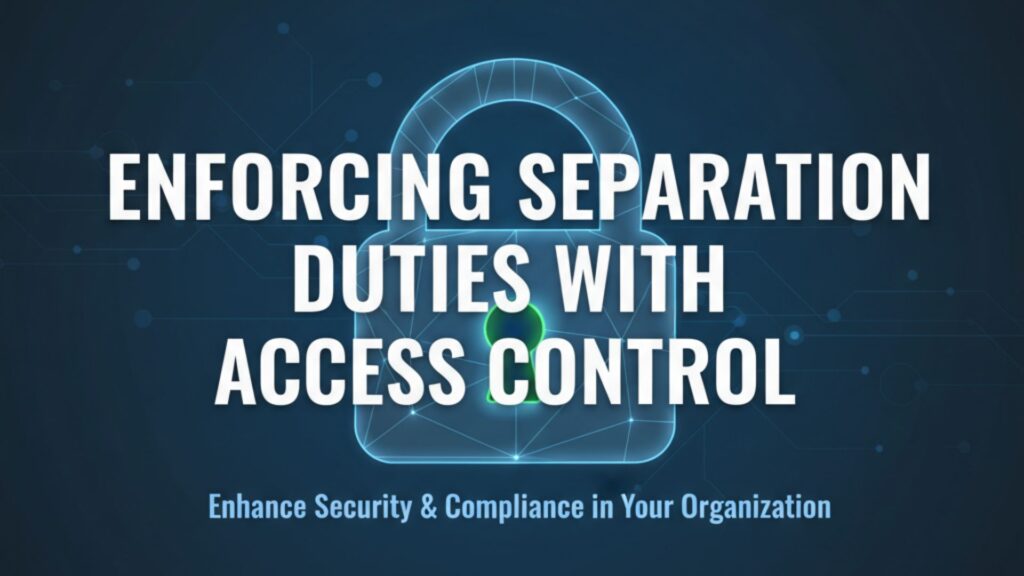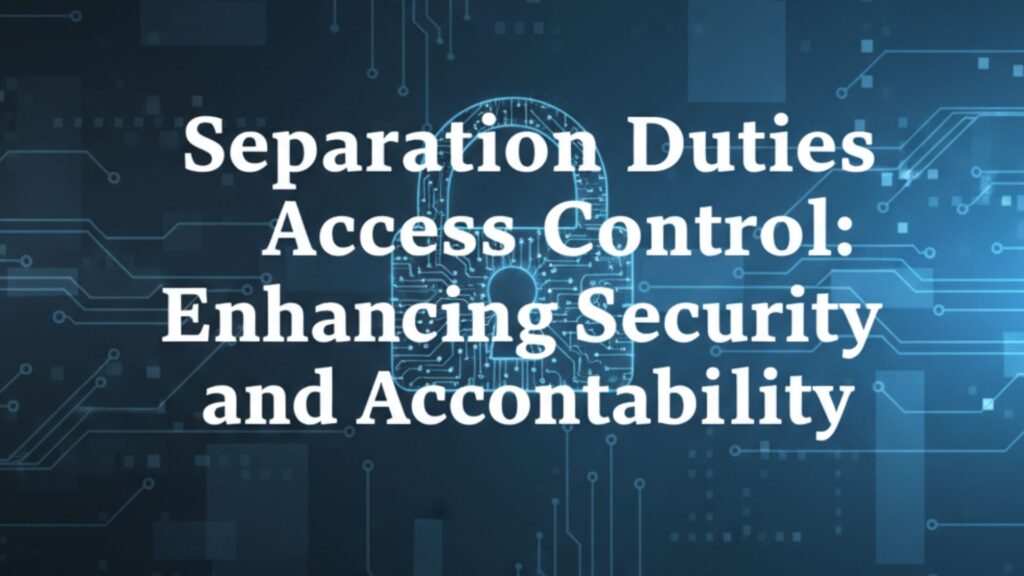
Most development teams just hand out access like Halloween candy. There’s a better way: dividing up who’s got the keys to what. A bank’s tech lead shared a story that still makes folks cringe – one person handling both payment processing and approvals. That went about as well as you’d expect. That’s where separation of duties steps in.
We teach teams to split these tasks up (one person submits, another signs off), making it a real headache for anyone thinking about funny business. Our training shows developers the nuts and bolts of coding these guardrails right into their projects. Want to see the step-by-step breakdown? Keep reading.
Key Takeaways
- Break up important tasks between different people to stop fraud
- Match permissions to actual job roles
- Follow rules that keep operations in check and trackable
Understanding Separation Duties Access Control
Think of separation of duties like a busy kitchen – you don’t want the same chef cooking and taste-testing their own food. We’ve seen too many companies learn this lesson the hard way. The idea’s pretty straightforward: split up who can do what, so nobody’s got too much power.
Our training shows developers the nuts and bolts of coding these guardrails right into their projects, and we often point them to real-world examples of separation of duties in development so they can see how it plays out in practice.
Here’s what typically gets divided up:
- Sign-offs (who can green-light changes)
- System access (who gets the keys)
- Record keeping (who writes it down)
- Double-checking (who makes sure it’s right)
Here’s something we noticed in the field – companies that take this seriously catch problems way faster than those who don’t. Split these duties up right, and you’ve got a built-in safety net against both honest mistakes and the not-so-honest stuff.
Why Separation Duties Matters: Fraud Prevention and Risk Mitigation
Fraud rarely happens with just one set of hands. After teaching secure development for over a decade, this truth stands out crystal clear. Think about a bank teller who’s got their fingers in everything – deposits, withdrawals, approvals, the works. Yeah, we’ve seen it go south fast.
Students come to class shaking their heads about that one person who could change the books and approve their own edits, walking out with thousands while everyone else was looking the other way.
Breaking up responsibilities just makes sense. People mess up sometimes – that’s just human nature. But having multiple sets of eyes catches those slip-ups before they turn into real problems. These guardrails keep honest folks honest and make it harder for the not-so-honest ones to pull anything funny.
The whole thing works better than most think:
- Big changes need at least two people to sign off
- Staff only get the access they need for their job
- Every click, edit, and approval gets logged
Identity management’s a huge piece of this puzzle. It’s pretty wild what can happen when someone switches departments but keeps their old access. We’ve watched that movie before – spoiler alert: it doesn’t end well.
Enforcing Separation Duties with Access Control

Breaking down access control isn’t rocket science, but people mess it up all the time. Our bootcamp students usually get it when we compare it to a bank vault – you need both the manager and teller to open it, not just one person.
Role-based control (RBAC) makes the most sense in practice. We’ve helped hundreds of companies set this up, and it’s always easier to manage roles than individual permissions.[1] Think about it – would you rather update permissions for 50 people one by one, or just change one role that applies to all of them?
Static enforcement means setting things up so certain roles just can’t do certain things. Like, the person who writes the checks can’t approve them. Period. For the trickier stuff, there’s dynamic enforcement – that’s where you need someone else to check your work in real-time.
Both static and dynamic enforcement matter, but the real gains come from implementing separation of duties directly into role-based access controls instead of relying on after-the-fact reviews.
Most breaches we investigate started because someone had way more access than they needed. That’s why we hammer home these concepts in every training session – because this stuff matters in the real world.
Compliance Standards Demand SoD Controls

Regulations don’t care about excuses – that’s something we drill into every bootcamp class. SOX, ISO 27001, NIST 800-53… they all want the same thing: proof that nobody’s got too much power. Our audit team spent years watching companies scramble during reviews because they couldn’t show who had access to what.
Most folks think throwing together some quick documentation before an audit will cut it. Spoiler alert: it won’t. We’ve seen companies fail audits because their “separation of duties” was just words on paper. Real compliance needs actual controls built into daily operations.[2]
What really makes auditors happy?
- Clear role definitions (no “misc admin” roles)
- Proof that nobody’s got conflicting access
- Solid paper trails for approvals
- Regular access reviews (not just annual rubber-stamping)
The smart companies don’t wait for the audit season – they check this stuff constantly. Our most successful clients run monthly access reviews and actually act on the results.
Real-World Examples of Separation Duties Access Control
Look, this isn’t just theory – we see these controls save companies every day. Take this fintech startup we worked with last year. Their payment system let the same person create and approve transactions. Three months and one rogue employee later, they learned why that’s a terrible idea.
Banking, tech, and healthcare all apply these principles differently, and we often share separation of duties examples in IT to show how teams actually divide responsibilities in practice. Simple but effective.
Tech companies need this too. We teach our dev teams that code deployment should work like a nuclear launch – it takes more than one person to push the button. One developer writes the code, another reviews it, and only the ops team can push to production. Sounds like extra work until that one bad deploy that could’ve wiped out the database.
Healthcare’s got their own spin on this. Doctors see medical records, billing staff handle insurance stuff, and IT manages the systems. Nobody gets full access to everything, because nobody needs it.
How Separation Duties Integrate with IAM and System Controls
Credit: Alexander C. Hubbard
Let’s be real – identity management isn’t exactly thrilling, but messing it up causes real headaches. Last month, a client called us panicking because an ex-employee still had access to their production systems three months after leaving. That’s the kind of stuff that keeps security folks up at night.
IAM systems do the heavy lifting here. They track who’s who, what they can do, and most importantly – what they shouldn’t do. Our training always hits this point hard: automate everything you can, because humans forget stuff.
Think about every time someone switches teams or gets promoted. Their old access should go away, but without proper IAM setup, it usually doesn’t. We call this “privilege creep” – it’s like digital hoarding, and it’s just as messy.
A solid IAM setup handles:
- New hires getting exactly what they need
- Access changes when people move around
- Quick lockouts when someone leaves
- Detailed logs of who did what
Separation Duties Access Control: Enhancing Security and Accountability

After training thousands of developers, one thing’s crystal clear – security works best when it’s baked in, not bolted on. Separation of duties isn’t just some checkbox for auditors. It’s about stopping problems before they start.
Every company that’s survived a major incident knows this truth: nobody should have the keys to the whole kingdom. Our most successful students take this to heart, building controls right into their code from day one. They split up who can change things, who can approve those changes, and who can push them live.
The payoff? Fewer accidents, better audit trails, and way less stress during compliance reviews. One banking client cut their security incidents by 60% just by properly separating duties across their dev teams.
Remember that mess with the ex-employee we mentioned earlier? Good separation of duties would’ve caught that way sooner. That’s why we push this stuff so hard in our bootcamps – because in the real world, these controls really matter.
Conclusion
Splitting up important tasks between different people isn’t just smart – it’s necessary. When one person has too much control, mistakes and theft become real risks. Most companies divide duties by giving specific access rights to match each job role.
Some tasks might need two people to complete (like those big bank transfers that need multiple approvals). Regular checkups on who can do what, plus good record-keeping of who did what, keep everything running safely. Think of it as having multiple locks on a valuable safe.
Want to take your security practices to the next level? Join the Secure Coding Practices Bootcamp to deepen your knowledge and strengthen your team’s defenses.
FAQ
How does separation of duties relate to access control and fraud prevention?
Separation of duties (SoD) works closely with access control to lower the risk of mistakes or fraud. By splitting key jobs between people and tying them to role-based access control (RBAC), you build stronger internal controls.
This setup makes fraud prevention easier, since no one person can approve, record, and reconcile the same task. It also strengthens security compliance and reduces risk by sharing authorization control and custody control. That way, a single insider threat has less chance to slip through.
What’s the difference between static SoD and dynamic SoD in system access control?
Static SoD sets strict rules that stop one user from holding conflicting roles, while dynamic SoD checks for conflicts in real time. Both approaches rely on access management, role conflict detection, and permission segregation. With system access control in place, dynamic SoD adjusts when task division changes.
Static SoD is easier to enforce but less flexible. Both reduce insider threat risks and improve process oversight. Many organizations use them together as part of security principles, internal risk controls, and a broader segregation policy.
Why do compliance controls and audit logs matter for segregation of duties?
Compliance controls show that segregation of duties, access review, and approval requirements are being followed. Audit logs and an audit trail create proof for internal auditing and security governance. Together they support reconciliation processes, transaction verification, and monitoring and verification of user roles.
Without them, it’s harder to track authorization control or confirm that fraud detection and anti-fraud controls are in place. They give auditors a check and balance system that proves operational controls, duty separation, and ethical controls are applied.
How do dual control and multi-person control protect financial transactions integrity?
Dual control and multi-person control ensure no single person can finish sensitive operations alone. This strengthens financial controls, operational controls, and financial transactions integrity. For example, one worker might start a payment while another approves it, creating task separation.
Combined with approval workflows and multi-level approval, these controls reduce conflicts of interest and reinforce security best practices. They also connect to control frameworks, process segregation, and change control, making fraud prevention and segregation enforcement much stronger in everyday work.
How does identity and access management support duty separation and access segregation?
Identity and access management (IAM) helps define user roles, manage user access provisioning, and enforce access rights. It makes access segregation easier by matching access to least privilege and role-based segregation. This supports duty separation, transaction segregation, and system authorization.
Privileged access management can limit sensitive operations, while access review ensures ongoing compliance controls. IAM also enforces security policy, security segregation, and environment separation. These steps strengthen process controls, approval workflows, and policy enforcement to uphold strong security governance.
References
- https://en.wikipedia.org/wiki/Role-based_access_control
- https://en.wikipedia.org/wiki/Separation_of_duties

